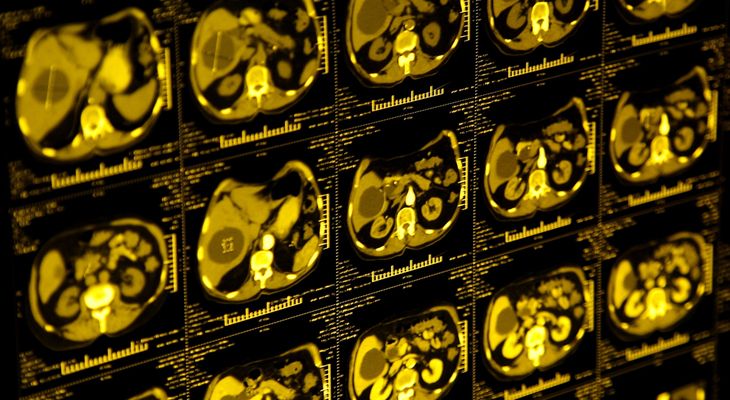NELSON Trail: CT Lung Cancer Screening Benefits Confirmed
Decade-long trial shows frequent CT screening reduces high-risk smokers’ likelihood of dying from lung cancer.

Frequent, annual low-dose computed tomography (CT) screening is advantageous for individuals at high risk for developing lung cancer, according to results from the decade-long NELSON trial.
According to findings, published in the New England Journal of Medicine, study participants who received periodic screening were much less likely to die from lung cancer than those who didn’t get screened.
The results support the assertion that CT screenings for lung cancer have a significant impact on reducing the likelihood that a high-risk smoker will die from the disease. The trial’s results echoed the outcome of the U.S.-based National Lung Screening Trial which revealed that three rounds of annual CT screening – rather than chest radiography – reduced lung cancer mortality.
“The NELSON trial showed that volume CT lung-cancer screening, with low rates of follow-up procedures for test results suggestive of lung cancer, resulted in substantially lower lung-cancer mortality than no screening among high-risk persons,” wrote lead study author Harry J. de Koning, M.D., Ph.D., professor of public health at Erasmus MC-University Medical Center in Rotterdam. “Volume CT screening enabled a significant reduction of harms, such as false positive tests and unnecessary workup procedures, without jeopardizing favorable outcomes.”
To demonstrate the benefit of low-dose CT screening, the NELSON trial, based on the Netherlands and Belgium, enrolled 15,792 participants between ages 50 and 74 – 13,195 men and 2,594 women – who had a high risk of lung cancer. They were either current smokers or former smokers, who quit less than 10 years prior, who smoked more than 15 cigarettes a day for more than 25 years or more than 10 cigarettes a day for more than 30 years.
As part of the trial, participants received four rounds of low-dose CT screening at one-year, two-year, and 2.5-year intervals. Others in the trial received no screenings. Overall, results showed the screenings reduced total lung cancer deaths by 24 percent in men and 33 percent in women.
Investigators followed participants for 10 years, and the data revealed a higher cumulative incidence of lung cancer in the screening arm of the predominantly male primary analysis group than compared to the control group – 5.58 versus 4.91 cases per 1,000 person-years, respectively. Additionally, the incidence of lung cancer mortality was lower in the screening group – 2.50 versus 3.30 deaths per 1,000 person-years.
These results point to a cumulative rate ratio for lung cancer mortality of 0.76 at 10 years for the screening group. Data analysis pointed to a similar rate for female participants – 0.67 at 10 years. This rate indicated a slightly greater benefit among women, though investigators noted the female participant pool was smaller.
Putting Lung Cancer Screening Doubts to Rest
There are several aspects of the NELSON trial that underscore the strength of the findings. In an editorial accompanying the study, Stephen Duffy, Ph.D., from Queen Mary University London and John Field, Ph.D., from the University of Liverpool, outlined various positive characteristic of the trial.
“Our job is no longer to assess whether low-dose CT screening for lung cancer works: it does,” they wrote in the editorial. “Our job is to identify the target population in which it will be acceptable and cost-effective.”
They noted these points about the findings:
First, NELSON investigators screened participants at longer time intervals than the NLST. The longer time frames confirm the safety and efficacy of having more than one year between screening.
Second, both NELSON and NLST demonstrated greater CT lung screening benefits in women than in men. More work needs to be done to determine why this is the case, they said.
Third, the similar increase in lung cancer mortality between both trial groups noted after roughly 2.5 years points to the protective effect of screenings for roughly 2.5-to-3.5 years.
Fourth, of the scans, 2.1 percent were true positives that called for further evaluation. The positive predictive value was 43.5 percent, and the false-positive rate for all screening rounds was 1.2 percent.
What is the Best Use of AI in CT Lung Cancer Screening?
April 18th 2025In comparison to radiologist assessment, the use of AI to pre-screen patients with low-dose CT lung cancer screening provided a 12 percent reduction in mean interpretation time with a slight increase in specificity and a slight decrease in the recall rate, according to new research.
The Reading Room: Racial and Ethnic Minorities, Cancer Screenings, and COVID-19
November 3rd 2020In this podcast episode, Dr. Shalom Kalnicki, from Montefiore and Albert Einstein College of Medicine, discusses the disparities minority patients face with cancer screenings and what can be done to increase access during the pandemic.
Can CT-Based AI Radiomics Enhance Prediction of Recurrence-Free Survival for Non-Metastatic ccRCC?
April 14th 2025In comparison to a model based on clinicopathological risk factors, a CT radiomics-based machine learning model offered greater than a 10 percent higher AUC for predicting five-year recurrence-free survival in patients with non-metastatic clear cell renal cell carcinoma (ccRCC).
Could Lymph Node Distribution Patterns on CT Improve Staging for Colon Cancer?
April 11th 2025For patients with microsatellite instability-high colon cancer, distribution-based clinical lymph node staging (dCN) with computed tomography (CT) offered nearly double the accuracy rate of clinical lymph node staging in a recent study.